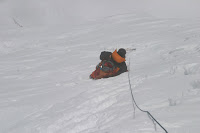By, Stephen Speckman
While Lhakpa Gelu Sherpa climbed the world's tallest peak earlier
this month, his wife Fulli was back at home in Draper climbing her
own mountain, one made up of the time and distance that had separated
her for so long from her husband and three children in Nepal.
 (Lhakpa Gelu Sherpa gets a warm welcome home - photo by,
(Lhakpa Gelu Sherpa gets a warm welcome home - photo by,
Laura Seitz, Deseret Morning News)
It had been six months since she had seen her children, Ang Dawa,
Nima and Tashi - they were at a boarding school in Katmandu until
their parents were able to successfully navigate immigration laws to
secure the proper visas. And after two months without Lhakpa, Fulli
was at the Salt Lake City International Airport on Wednesday to
embrace her entire family.
"I'm so sad," she said about the wait. "Now, I'm happy."
Lhakpa said it was hard getting his children out of Nepal and to
their new home in Utah. He thanked Utahns Jerry Mika and Roger Kehr
for their help with all of the red tape.
"I'm so very happy," Lhakpa said. "Everyone is together."
Lhakpa and fellow Draper resident Apa Sherpa made history May 16
in Nepal when they led an all-Sherpa team of climbers, dubbed the
SuperSherpas Expedition, to the summit of Mount Everest.
 (Apa Sherpa greets well wishers at Salt Lake City International
(Apa Sherpa greets well wishers at Salt Lake City International
Airport -- photo by, Laura Seitz, Deseret Morning News)
For Apa's 17th Everest summit (a world record), he and Lhakpa also
helped recover the bodies of two Korean climbers. Base-camp manager
Jerry Mika said this season has been a particularly deadly one on
Everest, which claimed the lives of three people close to members of
the SuperSherpas team.
Normally, foreign travelers pay huge sums of money to outfitters
for a go at reaching the mountain's 29,035-foot peak. Members of
Nepal's isolated Sherpa community, living in the high Himalayas, are
typically hired by the outfitters as porters.
Sherpas, who often share the same last name although they are not
directly related, carry heavy loads so that the foreign climbers can
stay light, increasing the chance that they will reach the summit.
The Sherpas endure the same extreme weather conditions as their
clients. And Sherpas, like Lhakpa and Apa, set ropes for climbers,
keep them out of danger and even rescue Westerners who get in trouble
on the mountain.
But after the high-paying customers reach the peak, all the glory
in the media goes to them, while Sherpas comparatively get little
recognition.
"They don't mention anything about Sherpas," Apa Sherpa said. "I
don't know why."
The pay for Sherpas, considered the world's best high-altitude
climbers, is often only a small fraction of what climbers pay for the
Everest experience.
So the twist for this expedition was that Mika and other Utahns -
Westerners - were the support crew for the Sherpas. The goal was to
raise awareness of Nepal's Sherpa community and the struggles they
face in getting health care for their families and an education for
their children.
Just as sweet as summiting Everest, Apa and Lhakpa were able to
leave behind $2,500 each in donated money for education and medical
needs in their hometowns before heading back to Utah.
 (The welcoming party for Utah members of the SuperSherpas Expedition
(The welcoming party for Utah members of the SuperSherpas Expedition
-- photo by, Laura Seitz, Deseret Morning News)
At the Salt Lake City International Airport, Apa's wife Yangjin
and their three children, Tenzing, Pemba and Dawa, were relieved to
have Dad back home.
"My heart feels good and happy," Yangjin said.
Some in Apa and Lhakpa's families are still learning English. Most
of their children will be or are attending schools in Draper. Apa
works for an outdoor retailer, and since moving to Utah Lhakpa has
been employed by Snowbird Ski & Summer Resort's coffee house Peak
Java.
A book and documentary are in the works about the SuperSherpas
expedition. One goal of those two projects is for more people beyond
the climbing community to learn about Sherpas. Fund-raising efforts
will continue in order to help Sherpas back in Nepal.
"It was about the Sherpas," said Rulon Bunker, who was part of the
support crew at base camp on Everest. "Our mission was to support the
Sherpas."
Jerry Mika, who returned Wednesday with Apa and Lhakpa, was in
Katmandu when the two Sherpas were paraded through the streets as
heroes and cheered by Nepalese dignitaries and citizens.
"Hopefully, Salt Lake City welcomes these Sherpas like Nepal did,"
Mika said.
The moment in Katmandu is something that will stay a lifetime with
Apa Sherpa.
"All the Nepalese people are very proud," he said.
Apa is hopeful the book and documentary about the team will change
the way the world views Sherpas and what it knows about them.
The medical community also will be learning more about Sherpas
based on research conducted during the expedition to figure out why
Sherpas perform so much better than anyone else under extreme
physical and mental stress at high altitudes.
As for Fulli and Yangjin, having their husbands home means that
their prayers were answered - and that the revered Mount Everest,
known to Sherpas as Chomolungma, or "Goddess Mother of the Land," had
a hand in delivering these two fathers back to their families, safe
and alive.












